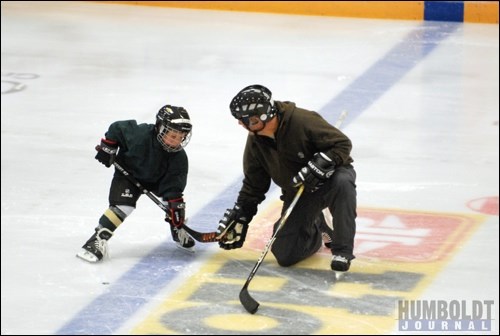Last week wasn't just about turkey. It was about ice.
Humboldt's minor hockey teams all took to the ice, for some teams for the first time this season, over the Thanksgiving weekend.
Though camps and exhibition games for the AA teams started in mid-September, the second weekend in October marked the first skate for the rest of the Humboldt Minor Hockey (HMH) teams.
"We have lots of kids again," reported HMH president Kelsey Lindal last week.
The introductory program (IP), which is also known as Junior Novice, has three teams and about 35 kids registered, Lindal said, and the Senior Novice level has the same.
At the Atom level, there are two teams - one AA and one A - and about 22 players in total.
At the Pee Wee level, there is one AA team, and two more teams at the A level, involving close to 40 skaters.
There are also two Bantam teams - one A and one AA - with about 35 kids in total.
At the Midget level, there are two teams, including one at the AA level, and about 40 players involved.
That's 15 teams, up from 13 last year.
This means that ice time at the Elgar Petersen Arena (EPA) will be extremely tough for each team to get this year.
To try and ease the pressure, teams from the Pee Wee level down will have joint practices, Lindal said. That means all three teams at the Novice and Atom levels will be on the ice at the same time, which can makes things a little chaotic.
HMH has again agreed to take three morning slots per week, Lindal added. It is a tough sell for parents and kids, he admitted.
"But it shows the City we are trying to use the facility to maximum capacity, so we can speed up the long term plans for building another facility," he said.
Last year, over 40 per cent of the ice rented by HMH teams was out of town.
"It's been like that for the last four years," Lindal noted.
HMH teams have sourced ice in Muenster, LeRoy and Bruno, and this year, will be adding Watson to their list.
Teams are not only heading out of town for practices, but for games as well. It's not often that some teams get to actually play their "home" games in their home arena.
But ice is even getting hard to come by in some of the smaller towns, due to growing hockey programs and natural ice surfaces.
"Fortunately, we get lots of weekend ice (at the EPA). But it's tough to co-ordinate all the teams to utilize that ice. Everyone has games and they need practise time."
Some teams are looking at weekend practice spots, Lindal said, and some are looking for weeknight game slots, to try and use the ice available at the EPA. But it won't work for every team, as game times really depend on the other teams in the league as well.
HMH teams, Lindal explained, play in four different leagues - the Centre 4 league, North Central and Last Mountain leagues, and the Bantam league is province-wide.
The solution to the ice issue? Another Humboldt arena, Lindal believes. And it can't be built too quickly for the HMH.
"I'm prepared to sign an agreement with the city right now for X amount of dollars to speed up the process," he said. "But that's not their focus right now."
Another challenge HMH will be facing this year is dealing with construction mid-season as changes are made to the EPA to accommodate the upcoming RBC Cup in May - Canada's national junior A hockey championship tournament.
"It's a complete joke, the fact that those (renovations) aren't done yet," he said. "They will do nothing but disrupt the entire season. I plead with parents to be patient."
HMH is likely the single biggest ice user at the Elgar Petersen Arena every month, Lindal noted. They spend about $10,000 a month on ice fees.
HMH fees did go up this year, Lindal said, because their ice rental fees went up.
"The city raised our ice rental fees five per cent. So our fees went up accordingly," he stated.
While ice time is always HMH's biggest challenge, finding coaches can also be tough.
"It's too easy for parents to write the cheque and move on," Lindal said. "Like any volunteer-based organization, it's tough to get volunteers."
They are still looking for coaches for the younger age groups, he noted, as some of their most dedicated volunteers with the IP program are moving up this year as their kids get older.
"We meed more dedicated dads or moms for the five- and six-year-olds," he said.
The issue may be, he added, that the practise times for the IP program are before the regular workday ends, so a coach needs to have flexible hours.
The organization is continuing with their sweater replenishment program, buying two sets of new jerseys for the Pee Wee A team, and some for the younger teams as well, thanks to sponsorship of area businesses.
HMH also once again had evaluators from the Saskatchewan Hockey Association (SHA) come out to evaluate the players in the AA programs.
"It's a fair and transparent process," Lindal said about why they chose to do it again this year after trying it out last season. "The perception of bias is removed."
He continued, saying, "More associations are doing it this year.... Obviously, it's a good thing or other associations wouldn't have done it."

